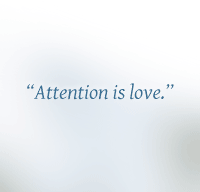
There is a lot of show and tell about creativity these days. I understand the interest. Not so much now, when I can see and delight in my daughter for how colorful she already is, but in the earlier days of child-rearing when I was certain that someone other than me – a specially trained music teacher, art teacher, or storyteller – could do more to prime my daughter’s creative instincts than I could. I sought out those uniquely qualified people, I entrusted the both of us to their able hands, and my daughter and I got out of the house and enjoyed ourselves immensely. These activities were creative exercises, but they were not at all necessary to cultivating creativity.
I was doing it backwards. I thought of creativity as one of a myriad attributes to be managed; an aptitude to instill. Now I see creativity much differently. All children are creative and all adults are creative because life is creation itself. Spontaneous, dynamic, unpredictable, inexplicable and rich with inherent and inscrutable meaning. Creativity doesn’t always look like what we think it should look like, though.
***
The feeling that we lack creativity has given rise to a naturalistic movement – which could soon dwarf even Martha Stewart – giving us lush pictorials on creativity. Everything in displays of this kind defy my imagination: handmade, homemade, artistic, ingenious, and productive beyond human comprehension, or so it seems to me. After absorbing these images, soaking in a simmer of envy, disbelief and despair, I often feel my inspiration evaporate, more certain than ever that I am creatively disabled and DNA impoverished. I am, to be sure, no elephant among artists.
This is not at all the feeling I get after visiting at a certain address in Madison or resting under the blue sky in Virginia, each of which makes me feel right at home with my own kin.
And not so with Ginger Carlson, author of a new book called Child of Wonder. Ginger is an education consultant, teacher, speaker and mother who contacted me a little while ago and offered to send me her book. I instantly agreed for reasons of universal karmic indebtedness. Having plowed this tough turf myself makes me eager to pay back the kindness of strangers. Ginger’s work is full of practical, encouraging, well-researched pedagogy and sane advice for nurturing creativity in your children and yourself. And get this: not one of these ideas requires that I sew, knit, embroider or quilt; grow my own leeks; gather fresh gooseberries; keep small farm animals; make my own curtains; distress my own hardwoods; or hold a paintbrush in my nostril. Those are all clever and worthy ideas but they are ideas that I’m not likely to use today unless I twist them into a switch and beat myself back into my cozy snail shell.
***
Ginger covers many of the same bases but without an outcome-orientation. In other words, her take on creativity isn’t about how it looks, but about how it acts. Her approach to being creative is more than crafts. To wit, some of the unintentional Zen wisdom I gleaned from her pages:
“Let your child be alone.”
“Step outdoors.”
“Don’t ignore the wind.”
“Move your eyebrows.”
“Collect paper clips.”
“Don’t underestimate snails.”
“Question your agenda.”
“Say yes more often.”
In short, I liked Ginger’s use of the everyday and everywhere, the breadth of material and resources, which touch on all the ways we fear we will fail our children’s natural curiosity.
What I liked most about the book is that Ginger asked me to read it. I, for one, recognize that single act as a creative leap of the boldest kind.
And that gave me the creative opportunity to say yes.
Furthermore, she has inspired me to inch along all next week talking about creativity, during which I will make almost no apparent progress and few will call it pretty, least of all me.















